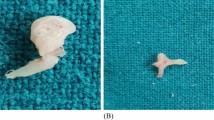Abstract
Ossicular necrosis and erosion is commonly seen in CSOM with cholesteatoma but can also occur in tubotympanic CSOM. This usually comes as a surprise during surgery. Preoperative knowledge of ossicular necrosis helps the surgeon to be better prepared for the surgery and ossicular construction if required. Hence, this study is intended to identify the pre-operative indicators of ossicular necrosis. This cross sectional study was conducted in Father Muller Medical College in Mangalore. Sixty nine consecutive patients with tubotympanic CSOM underwent a detailed clinical examination with pure tone audiometry and subsequently tympanoplasty with or without cortical mastoidectomy. All clinical findings, pure-tone audiometry, and intraoperative otomicroscopic observations were recorded. Incidence of ossicular necrosis was 23 %. The incus was most frequently eroded followed by malleus and then stapes. On bivariate analysis patients age above 30 years (p = 0.05), duration of CSOM more than 10 years (p = 0.02), presence of granulation (p < 0.05), absence of tympanosclerosis (p = 0.01), moderately severe (45–60 dB) hearing loss (p = 0.01) and an air bone gap of more than 55.7 dB in the right ear and 63.95 dB in the left ear was found to be statistically significant (p < 0.05). On multivariate analysis only presence of middle ear granulation tissue was found to be the significant predicator [(p = 0.005), OR 14.37, 95 % CI 2.26–90.0]. The presence of granulation tissue and a wide air bone gap on pure tone audiometry were the best indicators of ossicular necrosis. Preoperative identification of these indicators can help the surgeon to be better prepared for the surgery.
Similar content being viewed by others
References
Schuknecht HF (1993) Pathology of the ear, 2nd edn. Lea and Febiger, Philadelphia
Thomsen J et al (1974) Bone resorption in chronic otitis media. A histological and ultrastructural study. Ossicular necrosis. J Laryngol Otol 88:975–992
Rout MR, Mohanty D, Vijaylaxmi Y, Kamalesh B, Chakradhar M (2012) Prevalence of cholesteatoma in chronic suppurative otitis media with central perforation. Indian J Otol 18:7–10
Chole RA, Sudhoff HH (2010) Chronic otitis media, mastoiditis and petrositis. In: Naparko JK (ed) Cummings head and neck surgery. Mosby, Philadelphia, pp 1963–1978
Jeng FC, Tsai MH, Brown CJ (2003) Relationship of pre-operative findings and ossicular discontinuity in Chronic Otitis Media. Otol Neurotol 24:29–32
Anglitoiu A, Balica N et al (2011) Ossicular chain status in the otological pathology of the ENT clinic Timisoara. Med Evol XVII(4):344–351
Deka RC (1998) Newer concepts of pathogenesis of middle ear cholesteatoma. Indian J Otol 4(2):55–57
Sade J et al (1981) Ossicular damage in chronic middle ear damage. Acta Otolaryngol 92:273–283
Peake WT, Rosowski JJ, Lynch TJ III (1992) Middle ear transmission: acoustic versus ossicular coupling in cat and human. Hear Res 57:245–268
Shrikrishna BH, Jyothi AC, Sanjay G, Sandeep Samson G (2013) Age and gender differences in the incidence of non-cholesteatomatous chronic suppurative otitis media. Int J Res Pharm Biomed Sci 4(4):1172–1174
Jareen E, Vedantam R (2010) Preoperative predictors of incudal necrosis in chronic suppurative otitis media. Otolaryngol Head Neck Surg 142:415–420
Glasscock ME, Gulya AJ (2003) Surgery of the ear, 5th edn. BC Decker Inc., Elsevier India
Gulya AJ, Schuknecht HF (1995) Anatomy of the temporal bone with surgical implications, 2nd edn. Parthenon Publishing Group, Pearl River
Borg E, Nilsson R, Engstrom B (1983) Effect of the acoustic reflex on inner ear damage induced by industrial noise. Acta Otolaryngol (Stockh) 96:361–369
Feng H, Chen Y, Ding Y (2005) Analysis of preoperative findings and ossicular condition in chronic suppurative otitis media. Lin Chuang Er Bi Yan Hou Ke Za Zhi 19(1):7–8, 11
Ingelstedt S, Jonson B (1966) Mechanisms of gas exchange in the normal human middle ear. Acta Otolaryngol Suppl (Stockh) 224:452–461
Austin DF (1971) Ossicular reconstruction. Arch Otolaryngol 94:525–535
Thomsen J, Bretlau P, Balsev JM (1981) Bone resorption in chronic otitis media. The role of cholesteatoma: A must or an adjunct ? Clin Otolaryngol Allied Sci 6:179–186
Tos M (1979) Pathology of the ossicular chain in various chronic middle ear diseases. J Laryngol Otol 93:769–780
Kashyap SK, Singh B, Purohit JP, Chandrabhan, Singh AP, Azeem M (2015) Incidence of ossicular chain pathology in tubotympanic type of C.S.O.M. J Evol Med Dent Sci 67:11701–11707. doi:10.14260/jemds/2015/1687
Author information
Authors and Affiliations
Corresponding author
Ethics declarations
Conflict of interest
None.
Ethical approval
All procedures in this study were performed in accordance with the ethical standards of the institution and with the 1964 Helsinki declaration and its later amendments or comparable ethical standards.
Informed consent
Informed consent was obtained from all individual participants included in the study.
Rights and permissions
About this article
Cite this article
Jayakumar, C.L., Inbaraj, L.R. & Pinto, G.J.O. Pre-operative Indicators of Ossicular Necrosis in Tubotympanic CSOM. Indian J Otolaryngol Head Neck Surg 68, 462–467 (2016). https://doi.org/10.1007/s12070-016-0986-0
Received:
Accepted:
Published:
Issue Date:
DOI: https://doi.org/10.1007/s12070-016-0986-0



